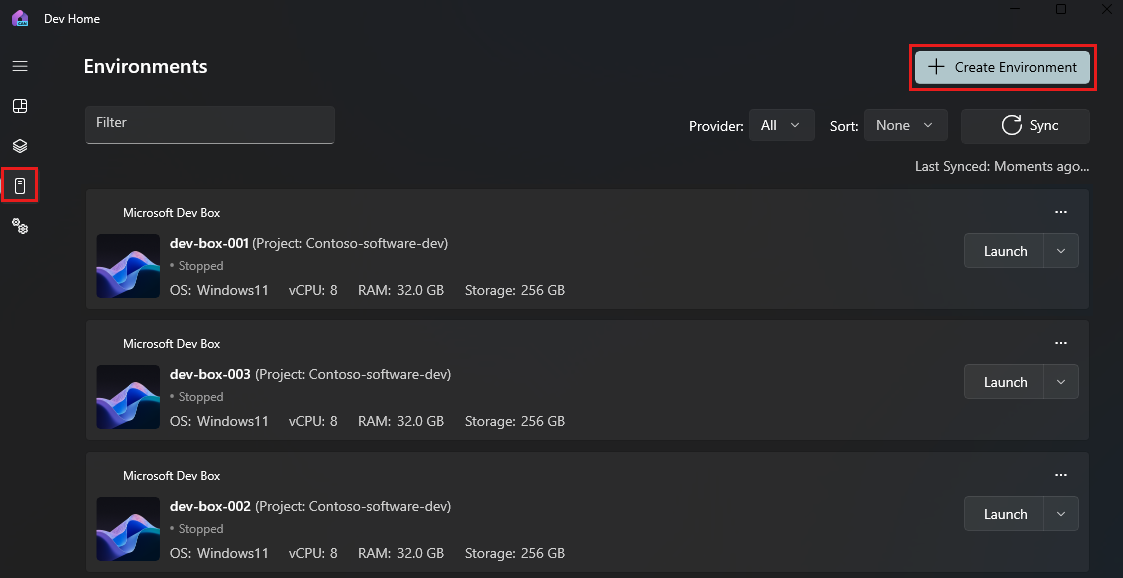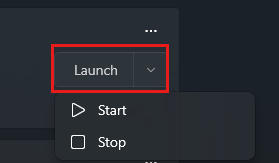Create reusable dev box customizations with Dev Home Preview
In this article, you learn how to use Dev Home Preview to create, customize, and connect to your dev box. Dev Home is a Windows application that helps you manage and interact with your dev boxes.
Important
Microsoft Dev Home is currently in PREVIEW. This information relates to a prerelease product that may be substantially modified before it's released. Microsoft makes no warranties, expressed or implied, with respect to the information provided here.
Prerequisites
To complete the steps in this article, you must:
- Have a dev center configured with a dev box definition, dev box pool, and dev box project configured so that you can create a dev box.
- Be a member of Dev Box Users for at least one project.
Install or update Dev Home
Dev Home is available in the Microsoft Store. To install or update Dev Home, go to the Dev Home (Preview) page in the Microsoft Store and select Get or Update.
You might also see Dev Home in the Start menu. If you see it there, you can select it to open the app.
Add extensions
Dev Home uses extensions to provide more functionality. To support the Dev Box features, you need to install the Dev Home Azure Extension.
To add an extension:
- Open Dev Home.
- From the left menu, select Extensions, then in the list of extensions Available in the Microsoft Store, on the Dev Home Azure Extension (Preview), select Get.
Create a dev box
Dev Home provides a guided way for you to create a new dev box.
Note
Dev Home uses the term Environments to refer to all local and cloud virtual machines.
To create a new dev box:
Open Dev Home.
From the left menu, select Environments, and then select Create Environment.
On the Select environment page, select Microsoft DevBox, and then select Next.
On the Configure your environment page:
On the Review your environment page, review the details and select Create environment.
Select Go to Environments to see the status of your dev box.
Connect to your dev box
Dev Home provides a seamless way for you to use the Windows App to connect to your Dev Box from any device of your choice. You can customize the look and feel of the Windows App to suit the way you work, and switch between multiple services across accounts.
If the Windows App isn't installed, selecting Launch takes you to the web client to launch the Dev Box. Dev Home provides a way to launch your dev box straight from the app.
Install the Windows App
- Go to the Microsoft store and search for Windows App or use this download link:.
- Download the app and install it.
Launch your dev box
Open Dev Home.
From the left menu, select Environments.
Select the dev box you want to launch.
Select Launch.

You can also start and stop the dev box from the Launch menu.
For more information on the Windows App, see Windows App.
Access your dev box from the start menu or task bar
Dev home enables you to pin your dev box to the start menu or task bar.
Open Dev Home.
From the left menu, select Environments.
Select the dev box you want to pin or unpin.
Select Pin to start or Pin to taskbar.
Customize an existing dev box
Dev home gives you the opportunity to clone repositories and add software to your existing dev box. Dev home uses the Winget catalog to provide a list of software that you can install on your dev box.
Open Dev Home.
From the left menu, select Machine configuration, and then select Set up an environment.
Select the environment you want to customize, and then select Next.
On the Set up an environment page, if you want to clone a repository to your dev box, select Add repository.
In the Add repository dialog, enter the source and destination paths for the repository you want to clone, and then select Add.
When you finish adding repositories, select Next.
From the list of application Winget provides, choose the software you want to install on your dev box, and then select Next. You can also search for software by name.

On the Review and finish page, under See details:
- Select the Environment tab to see the virtual machine you're configuring.
- Select the Applications tab to see a list of the software you're installing.
- Select the Repositories tab to see the list of public GitHub repositories you're cloning
Select I agree and want to continue, and then select Set up.
You can also generate a configuration file based on your selected repositories and software to use in the future to create dev boxes with the same customizations.
Related content
Feedback
Coming soon: Throughout 2024 we will be phasing out GitHub Issues as the feedback mechanism for content and replacing it with a new feedback system. For more information see: https://aka.ms/ContentUserFeedback.
Submit and view feedback for





